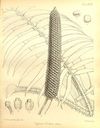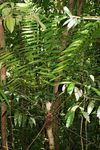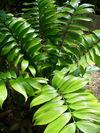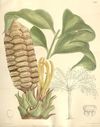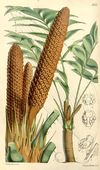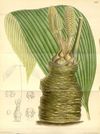Genus Zamia
Zamia is a genus of cycad of the family Zamiaceae, containing around 50 species, native to North, Central and South America.Species in the genus Zamia of plants
Zamia amblyphyllidia - A small, branching cycad with a subteranean stem. Leaves grow to about 1.5m long.
Palm Fern (German: Palmfarn) - Zamia fischeri has a subglobose shaped, subterranean stem about 8 cm in diameter, and is very similar to Zamia vazquezii. Zamia fischeri has a large stem and cones compared to its leaf size. The Cataphylls of Zamia fischeri are ovate, 1 to 1.5 centimeters long, and 1.5 to 2 centimeters wide. Zamia fischeri has leafs about 15 to 30 centimeters long; the petioles are 5 to 10 centimeters long, and rachis with 5 to 9 pairs of leaflets. The leaflets are papyraceous, tapering toward the base, and are acute apically with margins having several serrations in the outermost half. The larger middle leaflets are 3 to 5 centimeters long and .5 to 1 centimeters wide. Zamia fischeri has tan pollen cones usually ovoid-cylindrical in shape, obtuse towards the apex, 5 to 7 centimeters in length, and 1 to 2 centimeters in diameter, with the peduncle being 1.5 to 2.5 centimeters long. The seed cones are greenish-gray to gray, cylindrical to ovoid-cylindrical in shape, acuminate at the apex, 8 to 12 centimeters long and 4 to
Mexican Cycad - Zamia furfuracea is a cycad native to southeastern Veracruz state in eastern Mexico. Although not a palm tree , its growth habit is superficially similar to a palm; therefore it is commonly known as "Cardboard Palm" but the alternate name Cardboard Cycad is preferable. Other names include Cardboard Plant, Cardboard Sago, Jamaican Sago and Mexican Cycad . The plant's binomial name comes from the Latin zamia, for "pine nut", and furfuracea, meaning "mealy" or "scurfy".
Zamia integrifolia - This cycad produces reddish seed cones with a distinct acuminate tip. The leaves are 20-100 cm long, with 5-30 pairs of leaflets . Each leaflet is linear to lanceolate or oblong-obovate, 8-25 cm long and 0.5-2 cm broad, entire or with indistinct teeth at the tip. They are often revolute, with prickly petioles. It is similar in many respects to the closely related Zamia pumila, but that species differs in the more obvious toothing on the leaflets.
Coontie - This cycad contains reddish seed cones with a distinct acuminate tip. The leaves are 60–120 cm long, with 5-30 pairs of leaflets . Each leaflet is linear to lanceolate or oblong-obovate, 8–25 cm long and 0.5–2 cm broad, with distinct teeth at the tip. They are often revolute, with prickly petioles. It is similar in many respects to Zamia furfuracea, but with slightly narrower leaflets, and to Zamia integrifolia, which differs in the more commonly entire leaflets.
Zamia roezlii - Named by the Czech botanist Benedikt Roezl.
Zamia verschaffeltii - Zamia verschaffeltii is a species of plant in the Zamiaceae family. It is endemic to Mexico.
Zamia wallisii - Zamia wallisii was described in 1875 by Alexander Braun from material collected by Gustav Wallis in Colombia. The species was collected once again in 1888 by Guillermo Kalbreyer and then not seen again for 100 years. Both the Wallis and Kalbreyer collections were lost and no type specimen was extant resulting in some doubt about the existence of the species until its rediscovery in the 1980s.


